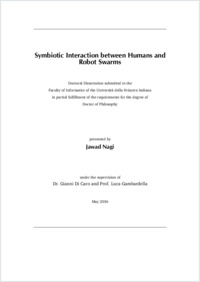Symbiotic interaction between humans and robot swarms
- Nagi, Jawad
- Gambardella, Luca Maria (Degree supervisor)
- Di Caro, Gianni (Degree committee member)
-
25.05.2016
232 p
Thèse de doctorat: Università della Svizzera italiana, 2016
Swarm robotics
Human-swarm interaction
Non-verbal communication
Data fusion
Distributed consensus
Spatial gestures
Swarm deployment
Cooperative learning
English
Comprising of a potentially large team of autonomous cooperative robots locally interacting and communicating with each other, robot swarms provide a natural diversity of parallel and distributed functionalities, high flexibility, potential for redundancy, and fault-tolerance. The use of autonomous mobile robots is expected to increase in the future and swarm robotic systems are envisioned to play important roles in tasks such as: search and rescue (SAR) missions, transportation of objects, surveillance, and reconnaissance operations. To robustly deploy robot swarms on the field with humans, this research addresses the fundamental problems in the relatively new field of human-swarm interaction (HSI). Four groups of core classes of problems have been addressed for proximal interaction between humans and robot swarms: interaction and communication; swarm-level sensing and classification; swarm coordination; swarm-level learning. The primary contribution of this research aims to develop a bidirectional human-swarm communication system for non-verbal interaction between humans and heterogeneous robot swarms. The guiding field of application are SAR missions. The core challenges and issues in HSI include: How can human operators interact and communicate with robot swarms? Which interaction modalities can be used by humans? How can human operators instruct and command robots from a swarm? Which mechanisms can be used by robot swarms to convey feedback to human operators? Which type of feedback can swarms convey to humans? In this research, to start answering these questions, hand gestures have been chosen as the interaction modality for humans, since gestures are simple to use, easily recognized, and possess spatial-addressing properties. To facilitate bidirectional interaction and communication, a dialogue-based interaction system is introduced which consists of: (i) a grammar-based gesture language with a vocabulary of non-verbal commands that allows humans to efficiently provide mission instructions to swarms, and (ii) a swarm coordinated multi-modal feedback language that enables robot swarms to robustly convey swarm-level decisions, status, and intentions to humans using multiple individual and group modalities. The gesture language allows humans to: select and address single and multiple robots from a swarm, provide commands to perform tasks, specify spatial directions and application-specific parameters, and build iconic grammar-based sentences by combining individual gesture commands. Swarms convey different types of multi-modal feedback to humans using on-board lights, sounds, and locally coordinated robot movements. The swarm-to-human feedback: conveys to humans the swarm's understanding of the recognized commands, allows swarms to assess their decisions (i.e., to correct mistakes: made by humans in providing instructions, and errors made by swarms in recognizing commands), and guides humans through the interaction process. The second contribution of this research addresses swarm-level sensing and classification: How can robot swarms collectively sense and recognize hand gestures given as visual signals by humans? Distributed sensing, cooperative recognition, and decision-making mechanisms have been developed to allow robot swarms to collectively recognize visual instructions and commands given by humans in the form of gestures. These mechanisms rely on decentralized data fusion strategies and multi-hop messaging passing algorithms to robustly build swarm-level consensus decisions. Measures have been introduced in the cooperative recognition protocol which provide a trade-off between the accuracy of swarm-level consensus decisions and the time taken to build swarm decisions. The third contribution of this research addresses swarm-level cooperation: How can humans select spatially distributed robots from a swarm and the robots understand that they have been selected? How can robot swarms be spatially deployed for proximal interaction with humans? With the introduction of spatially-addressed instructions (pointing gestures) humans can robustly address and select spatially- situated individuals and groups of robots from a swarm. A cascaded classification scheme is adopted in which, first the robot swarm identifies the selection command (e.g., individual or group selection), and then the robots coordinate with each other to identify if they have been selected. To obtain better views of gestures issued by humans, distributed mobility strategies have been introduced for the coordinated deployment of heterogeneous robot swarms (i.e., ground and flying robots) and to reshape the spatial distribution of swarms. The fourth contribution of this research addresses the notion of collective learning in robot swarms. The questions that are answered include: How can robot swarms learn about the hand gestures given by human operators? How can humans be included in the loop of swarm learning? How can robot swarms cooperatively learn as a team? Online incremental learning algorithms have been developed which allow robot swarms to learn individual gestures and grammar-based gesture sentences supervised by human instructors in real-time. Humans provide different types of feedback (i.e., full or partial feedback) to swarms for improving swarm-level learning. To speed up the learning rate of robot swarms, cooperative learning strategies have been introduced which enable individual robots in a swarm to intelligently select locally sensed information and share (exchange) selected information with other robots in the swarm. The final contribution is a systemic one, it aims on building a complete HSI system towards potential use in real-world applications, by integrating the algorithms, techniques, mechanisms, and strategies discussed in the contributions above. The effectiveness of the global HSI system is demonstrated in the context of a number of interactive scenarios using emulation tests (i.e., performing simulations using gesture images acquired by a heterogeneous robotic swarm) and by performing experiments with real robots using both ground and flying robots.
- Language
-
- English
- Classification
- Computer science and technology
- License
-
License undefined
- Identifiers
-
- RERO DOC 261186
- URN urn:nbn:ch:rero-006-115288
- ARK ark:/12658/srd1318604
- Persistent URL
- https://n2t.net/ark:/12658/srd1318604
Statistics
Document views: 300
File downloads:
- Texte intégral: 200
